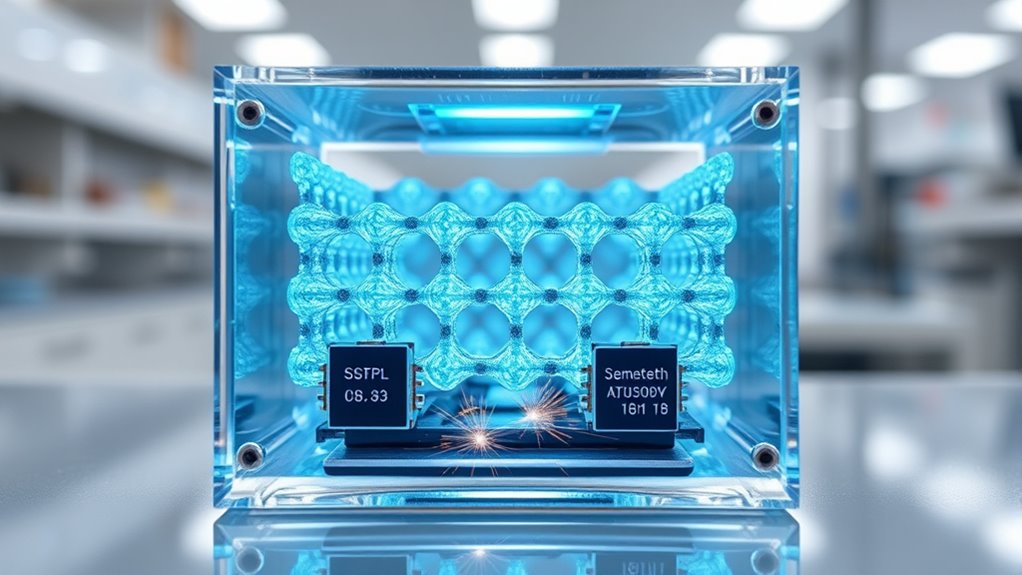Solid‑state refrigeration cools objects without compressors by using the Peltier effect, where electric current creates a temperature difference across thermoelectric modules made of semiconductor pairs. This technology has no moving parts, so it’s quiet, reliable, and eco-friendly, eliminating refrigerants and reducing noise and vibration. Its flexible, compact design makes it suitable for various applications like medical storage or electronics cooling. To discover how this innovative cooling method works and its benefits, keep exploring further.
Key Takeaways
- Solid-state refrigeration uses the Peltier effect, enabling cooling without moving parts or compressors.
- It consists of thermoelectric modules with n-type and p-type semiconductors that transfer heat when current flows.
- This technology offers silent, eco-friendly cooling by eliminating refrigerants and mechanical components.
- It allows precise temperature control and flexible design for various applications like medical and electronic cooling.
- Its compact, reliable structure makes it ideal for portable, space-constrained, or environmentally sensitive environments.

Have you ever wondered how solid-state refrigeration offers a quieter, more reliable alternative to traditional cooling systems? Unlike conventional units that rely on mechanical compressors, solid-state systems use thermoelectric devices based on the Peltier effect. These devices consist of alternating n-type and p-type semiconductor pillars, connected electrically in series and thermally in parallel. When direct current flows through them, a temperature difference develops across the device. The cooling side absorbs heat, which is then transported to the opposite side and dissipated, creating a refrigeration effect without any moving parts. The Peltier effect is fundamental to understanding how thermoelectric cooling operates.
Solid-state cooling relies on the Peltier effect, providing silent, reliable refrigeration without moving parts or refrigerants.
This design offers distinct advantages. Since there are no compressors or refrigerants involved, solid-state refrigeration eliminates vibrations, noise, and the environmental pollutants associated with traditional systems. Its reliability markedly surpasses that of compressor-based units because the absence of moving parts reduces wear and maintenance. This makes it especially suitable for environments that demand quiet operation, like medical offices, laboratories, or sensitive electronic setups. Moreover, these systems don’t use chlorofluorocarbons (CFCs), hydrofluorocarbons (HFCs), or hydrochlorofluorocarbons (HCFCs), making them environmentally friendly and safer for the planet.
You’ll also find that solid-state refrigeration allows for precise temperature control. Because the cooling effect is directly managed by adjusting electrical current, you can maintain specific temperatures with high accuracy. This capacity to fine-tune temperatures is valuable in applications such as medical storage, wine coolers, or electronic device cooling, where consistency is essential. Additionally, the ability to rapidly adjust temperatures without mechanical delays offers advantages for zonal climate control or thermal therapies, where specific temperature setpoints need to be maintained or changed quickly.
Design flexibility is another key benefit. These devices can be mounted in any orientation since they don’t depend on refrigerants or moving components. Their compact, sandwich-like structure enables integration into small or unconventional spaces, making them ideal for niche applications. Modular configurations allow stacking or layering to increase cooling capacity or achieve larger temperature differences, all while maintaining vibration-free operation. This flexibility extends their use to portable cooling units, mini-refrigerators, and mobile applications like in-vehicle cooling systems.
Frequently Asked Questions
How Long Is the Lifespan of Solid-State Refrigeration Devices?
You might wonder about the lifespan of solid-state refrigeration devices. Typically, thermoelectric modules last around 200,000 hours, or nearly 23 years with continuous use. These devices have fewer moving parts, reducing wear and tear, and operate only when needed. Their longevity largely depends on design quality and power management. While prototypes are still evolving, current research indicates that with proper maintenance and advanced materials, these devices could last decades.
Are Solid-State Refrigerers Environmentally Friendly Compared to Traditional Systems?
You’re wondering if solid-state refrigerers are more environmentally friendly than traditional systems. They are because they use solid materials instead of harmful gases like HFCs, which contribute to global warming and ozone depletion. These systems produce negligible leaks, have lower greenhouse gas impacts, and avoid ozone layer damage. Plus, they’re more energy-efficient, reducing overall environmental footprints. While challenges remain, their eco-friendly benefits make them a promising alternative to conventional refrigeration.
What Are the Typical Applications of Solid-State Cooling Technology?
You’re curious about where solid-state cooling technology finds its place. You’ll see it in consumer and commercial air conditioning, offering energy-efficient replacements for traditional units. It’s in electric vehicles, managing batteries and cabins efficiently. You’ll find it in medical equipment, providing precise temperature control silently. It’s also in food retail, electronics cooling, and aerospace, delivering miniaturized, eco-friendly solutions for heat management across various industries.
How Does the Cost of Solid-State Refrigeration Compare to Compressor-Based Systems?
You’re wondering how solid-state refrigeration costs compare to compressor-based systems. Generally, solid-state units have lower upfront costs, especially for small-scale or niche applications. However, they’re less energy-efficient, leading to higher operational costs over time. Maintenance is simpler and cheaper due to no moving parts, but the technology’s still evolving, which can make large-scale use more expensive. For small, precise cooling needs, solid-state systems can be a cost-effective choice.
Can Solid-State Refrigeration Operate Effectively at Extremely Low Temperatures?
Like a fragile ice crystal struggling in a warming world, your question probes the limits of solid-state cooling at extreme cold. You find that, despite advances, these systems still face hurdles like reduced efficiency and limited heat-pumping capacity at very low temperatures. While promising for precise, small-scale applications, achieving deep cryogenic cooling remains challenging, requiring further material innovations and engineering to unseal their full potential in ultra-low-temperature environments.
Conclusion
Imagine a future where your fridge hums silently like a whisper, powered by tiny, unstoppable quantum miracles. No noisy compressors, no bulky parts—just sleek, futuristic cooling at your fingertips. With solid-state refrigeration, you’ll feel like you’ve discovered the secret to endless, eco-friendly freshness. It’s so efficient, it’s almost like magic. Say goodbye to old-school cooling and hello to a world where your appliances are smarter, quieter, and cooler than you ever dreamed possible.










